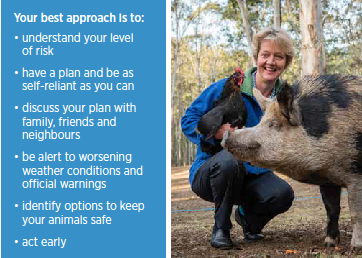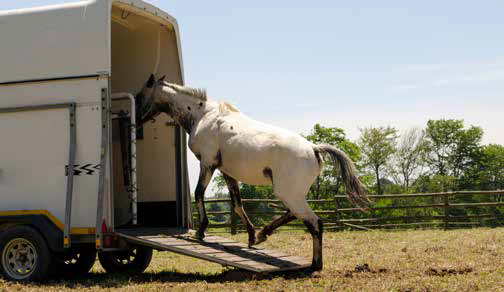

In an emergency your pets rely on you
Know your risks. Be prepared. Stay informed. Act early.
CHECKLIST FOR YOUR ANIMAL EMERGENCY KIT
- 3 days food and water, treats, bowls, can opener
- Current medications, animal first aid kit, vaccination certificate, care instructions in waterproof container
- ID tag, record of microchip number, photo of animal in case they get lost
- Secure crate/carrier, collar, harness, lead
- Bedding
- Comfort item - toy, blanket etc
- Toileting supplies - eg cat litter, poo bags etc
- Cleaning supplies & plastic rubbish bags
- Emergency contact numbers - local vet, friend or neighbour to assist you with animals, emergency accommodation

The following information is extracted from Keeping Your Animals Safe in an Emergency in the Blue Mountains Region v3, Sep 2020 which was produced by Blue ARC and the Resilience & Preparedness Group with the assistance and support of the NSW SES Hawkesbury Unit, Greater Sydney Local Land Services, NSW Department of Primary Industries, Agnes Banks Equine Clinic, Hawkesbury City Council, NSW Rural Fire Service, Dr Mel Taylor, Bushfire and Natural Hazards Cooperative Research Centre and Infrastructure NSW.
The publication contains general information only and should not be construed as advice. It does not take into account individual circumstances. Users relying on this information do so at their own risk. Users of this general information cannot claim loss or damages arising out of the use of this general information.
Animals in an Emergency
Be aware that your animals may behave differently in an emergency.
Animals, like humans, can feel stressed and anxious in an emergency. They may also pick up on your stress.
Animals will be affected by environmental changes that occur in an emergency — like floodwater, smoke, heat, flames, loud noises and sirens.
When animals are frightened they can become aggressive, can bite, scratch or kick (even if this is not part of their normal behaviour).
If animals are anxious, they could hide, run away or be difficult to move.
Prepare your animals early.
• With smaller animals you can put them in their crate, or in a room, where they are safe and contained.
• With larger animals, you can load them on a float or trailer, or move them close at hand in preparation for when you leave.
• If your animals are secure and safe, this will leave you free to take care of other members of your family.
If you act early your WHOLE family will be ready to leave when you need to move to safety.
How you can prepare as an animal owner
Over 90% of owners consider their animals to be family. Your animals WILL affect how quickly and easily you can evacuate if there is an emergency.
Most people have close bonds with their animals and will want to save them in an emergency — even if that means putting their own safety at risk. So it is important to be prepared, and to have plans for what you will do in an emergency, like a bush fire, flood or severe storm.
To keep your animals safe in an emergency, make them a part of your plan.
Remember, you are responsible for your animals. Don’t expect someone to come and rescue them for you. Have a plan for ALL your animals. You need to plan for the animals you can take with you and any animals you may need to leave behind.

Develop a plan …
and include all your animals
This is a plan for what you would do for your family, including your animals, in the event of severe storms and floods, bush fires, heat waves and other extreme weather events.
Remember: In an emergency you are responsible for the welfare of your animals. You are also responsible for managing your animals so they do not present a danger to other people or animals.
What should my plan include for my animals?
• Where to go and how to get there — planning to stay with family or friends is often the most comfortable and convenient option.
• What to take for your animals — prepare a ‘Grab and Go’ kit.
• How to identify, secure and transport your animals.
• If you have large animals like horses and livestock, a plan to relocate them early to a safer area.
Remember to practice your plan at least once a year.


Where are you taking your animals?
Decide well in advance the safest locations for your animals.
• Discuss with your friends and family if you can stay with them in an emergency and if you can bring your animals.
• Talk with your pony or equestrian club or reach out to animal groups on how you can support one another in an emergency. Create a network to communicate and act if you need to relocate your larger animals (e.g. horses, alpacas).
• Work with neighbours and friends to plan together.
Think about …
• How you will transport your animals? Will you need to make more than one journey? How long will it take?
• Do you have a cage for each cat? Do you have a collar and leash or crate for each dog? Does your dog need a muzzle?
• Have you practised loading your horses onto a float?
• Do you own a float? Is it registered and well maintained? If not, can you borrow a float?
How will you get to safety?
 Think about the routes you could take to relocate your family and animals.
Think about the routes you could take to relocate your family and animals.
Develop your plan to allow for one-way-in, one-way-out’ roads, or potential traffic changes such as roads and junctions becoming heavily congested, blocked or even closed.
Leaving early is the safest option.
Traffic conditions may result in trips taking longer than expected. Consider packing extra supplies eg water, and consider what to do if animals become stressed, need toilet stops, or are affected by smoke or extreme weather conditions.
Bush fires can move extremely fast. During a bush fire always follow the advice of the authorities.
Listen to media announcements (television, radio and online) as well as local radio and ABC local radio (702 AM).
Listen to warnings …
• Pay attention to your local weather forecasts, bush fire alert levels or local flood watch (indication of a developing weather pattern that might cause floods in one or two days).
• Monitor media, especially ABC Radio and local community radio for emergency information.
• Social media and mobile apps may also provide valuable information, e.g. RFS Blue Mountains District, NSW SES, & NSW SES Blue Mountains Unit Facebook pages; NSW RFS ‘Fires Near Me’ app.
.... and act early
• Stay calm, think clearly and put your plan into action
• Give yourself plenty of time to deal with any unforeseen problems
• Put your plan into place early — if you need to make more than one trip and/or to move large animals to a safe location
• Check with your local council and Live Traffic for road closure information www.livetraffic.com
Be prepared and relocate your animals to safety early — this can reduce stress for them and for you.

Animal Identification
Permanently identify your animals. This will help reunite you and your animals if separated during an emergency.
• Microchips are best for most animals.
• Ensure your personal details are up-to-date on the NSW Pet Registry.
• Take clear photos of your animals showing any distinct markings.
• Place a collar on your smaller animals with your name and phone number.
• Place ID tags or labels on any pet carriers.
• Horses can have emergency contact information attached to their mane through a tag e.g. Manestay.
Ensure your small acreage has a Property Identification Code (PIC)
A PIC number helps NSW Department of Primary Industries, Local Land Services and emergency services to know what animals you have in case of emergency.
Contact your Local Land Services office for advice.
Prepare a ‘Grab and Go’ kit
Prepare an evacuation kit for all your animals. You should be able to maintain your animals for 3 to 7 days.
Consider restraint and transport, food, water, toileting, medications, first aid, housing and bedding:
• cages or pet carriers for each animal; or
• muzzle and leash; or lead rope and head collar for each animal
• 3-7 days of food and water for each animal
• bowl or feed bucket
• can opener and spoon
• woollen blanket, towels or bedding
• animal medications and first aid items
• take a photo of your pet’s vaccination certificate
• litter and litter tray for cats
• poo bags for dogs
• toys
• and whatever else you feel is essential for the first 3 to 7 days.
What if you’re not at home?
When developing a good plan, be aware that you might not be at home.
When an emergency strikes you could be at work, on holidays or restricted from getting home (e.g. road closures).
So make sure:
• your neighbours, friends and family know your plan
• you have a list of people you can call who are willing and able to help relocate or evacuate your animals if you are not at home.
• spare keys to your house, shed, padlocked gates etc are available for others to use if necessary.
• everyone who lives, works or agists at your property knows your plan.
Remember that in an emergency phone lines can be down and people might be hard to reach. Talking about your plan with family, friends and neighbours BEFORE an emergency gives you the best chance to keep your animals safe.
What if you can’t take all your animals with you?
Sometimes you may not be able to take your animals with you.
Be prepared to give them the best chance to stay safe.
• Leave indoor pets inside in separate rooms with small or no windows.
• Ensure all animals have access to feed and fresh water in a heat resistant container or trough for at least 3-7 days as you may not be able to return to your property.
• Ensure all animals can be identified, such as with brands, microchips, NLIS, tags or have photos of distinctive markings in case they become lost. A mobile number written on both sides of large animals can assist.
• For stock, horses or non-indoor pets, prepare a safe paddock or refuge.
• If a safer refuge is unavailable, fix internal gates in an open position or cut internal fencing. This can give large animals opportunity to escape danger.
• Allow outdoor animals to roam freely. Do not tether them.
• NEVER open the external gates to your property. Animals loose on external roads are at great danger to themselves, other drivers and emergency services.
• Remove rugs, halters, and if possible, metal shoes, as they may be flammable, melt, cause burns or snag.

Having the conversation...

Preparedness for an emergency is strengthened through discussing issues, and making connections, with people in your community.
• consider the people you already know who you could talk with eg. family members; friends or neighbours; people in a group, club or church you belong to; staff at a local neighbourhood/community centre you attend etc.
• buddy-up with friends or neighbours and make plans to help each other if you are not home — or can’t get back in an emergency.
• visit your local RFS station and speak with officers there.
• speak to the staff at your local vet clinic
• research your options — where could you relocate your animals that is outside your local area?
• keep up to date with community initiatives — ‘Get Ready’ BM events are held in spring in the Blue Mountains every year, with RFS Open Days and stalls at community markets, ‘Meet Your Street’ events etc.
• join online communities — for example, animal-related groups on Facebook where you can share ideas and plan to support each other in an emergency.



